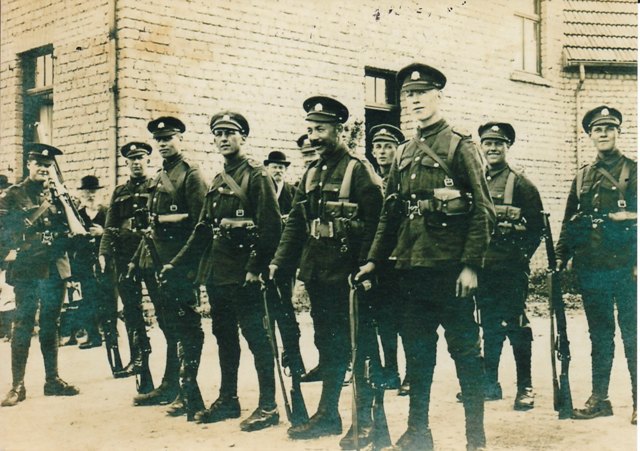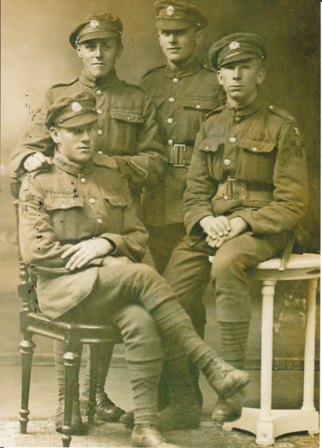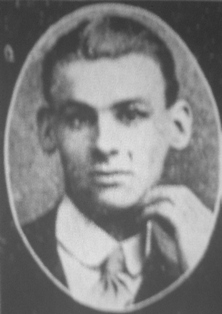The Bedfordshire Regiment in the Great War

Photographs and Biographies from the 4th Battalion
Private 10004, later Lieutenant Colonel Frederick Thomas SPICER, MBE, MC
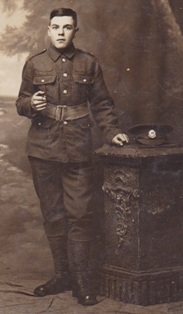
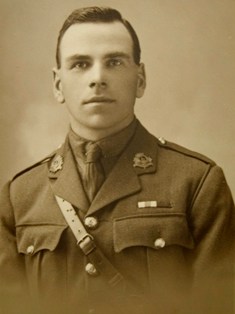 Dave
Stuckey contacted me about his Great Uncle, Frederick Spicer and as a
result of a combined effort, a great Regimental story surfaced.
Dave
Stuckey contacted me about his Great Uncle, Frederick Spicer and as a
result of a combined effort, a great Regimental story surfaced.
Frederick Thomas Spicer was born in Essendon near Hatfield, Hertfordshire in 1894, the eldest of eleven children. His father, Thomas Spicer, was born in Stevenage in 1890 and his mother Annie was from Walkern, near Stevenage.
Frederick was a farm labourer before the 18 year old enlisted into the army late spring to early summer 1912. He became Private 10004 of the Bedfordshire Regiment and was posted to the 1st Battalion on completion of his training, which was when the first photograph would have been taken.
Following his deployment with the battalion in Ireland, war was declared in 1914 and Frederick was one of the 1st battalion's 'Old Contemptibles' who landed in France on the 16th August. In 1914 alone, he was engaged in the battles of Mons, Le Cateau, the retreat to Paris, the Marne, the Aisne, La Bassee and the First Battle of Ypres. 1915 saw him involved in the Second Battle of Ypres and in the desperate defence of Hill 60 in April and May, after which time he had won promotion to Sergeant. In 1916 he was engaged during the Battle of the Somme when, as a Company Sergeant Major, he won a Military Cross and was commissioned in the field. His MC citation, dated 14/11/1916, reads:
"For conspicuous gallantry in action. He led his men in the attack with great courage .and determination, himself killing a number of the enemy. He has on many previous occasions done fine work."
Once officer training had been completed, Second Lieutenant Spicer, MC joined the 4th battalion in the field on the 20th May 1917 and appears throughout their diary until struck off the battalion strength in July 1918. He was present for the group photograph in September 1917 (shown below) and fought in the Third Battle of Ypres as well as being heavily engaged during the German Spring Offensives of 1918.
During the war he was wounded twice and gassed twice. He was also mentioned in despatches twice and was awarded the Russian St. George Cross over and above his Military Cross, 1914 Star with clasp and roses, Victory Medal and British War Medal.
His absolutely fascinating personal war diary can be seen at the Bedford County Records Office, covering his time in the 4th battalion in 1917 and 1918.
After the war Frederick's only child was born in 1919, being Barbara.
He then served in Ireland, where he was awarded a parchment for distinguished service as well as in the Shanghai Defence Force in the 1st battalion, India and Palestine. He was then moved into the 2nd battalion and appears whilst they were based in Colchester in the 1930s.
In February 1936 went to Egypt in the 2nd battalion and was recorded as being in command of D Company, 2nd battalion when they arrived at Jerusalem to help police the Arab rebellion. December 1936 saw him return to England and during the regiment's 250th anniversary celebrations in 1938, he was photographed escorting a dignitary who was inspecting his Company whilst on parade at St. Albans (below).
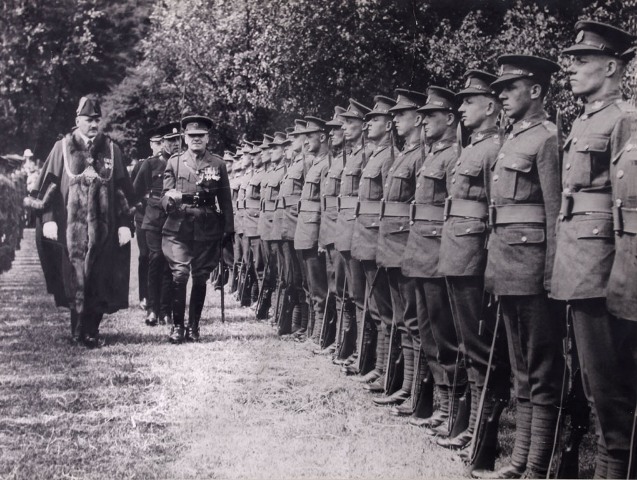
Major Spicer also served in France from 1939, throughout the 'Phoney War', until he was invalided home. He then served as a Brigade Major once recovered but unexpectedly died of a brain haemorrhage on the 28th November 1941, aged 47 whilst in command of the 6th battalion who were training at Bury St. Edmunds. Having served 29 years with the regiment and risen from Private to Lieutenant Colonel, he was given military funeral with full honours. The Regimental Sergeant Major and seven senior Warrant Officers who had served with him carried his coffin and he was buried in the Bury St. Edmunds cemetery, where he lies today.
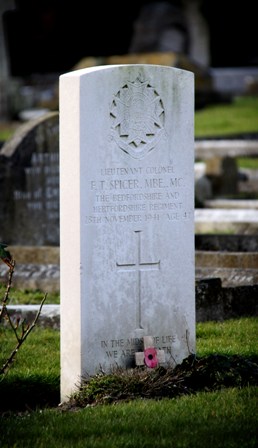
The next two photographs below are taken from the regimental Magazine "The Wasp" and are dated September 1917.
From the absence of Lt-Colonel Collings-Wells from the group, we can date it from between the 12th and 20th, when he was absent and in temporary command of the Brigade. Sadly, many of the faces you see below were killed or wounded six weeks later in the disastrous Second Passcendaele on the 30th October, when over 400 of the Battalion became casualties. And many of those who survived that battle would become casualties the following April when they fiercely opposed the German Spring Offensives. The first one shows the Officers and the second one the Sergeants. Whilst the Officers are named, unfortunately the Sergeants are not. Note that where the full names of the officers appear, I have identified them and added them based on my own files. As a result, should there be any inaccuracies, please contact me.
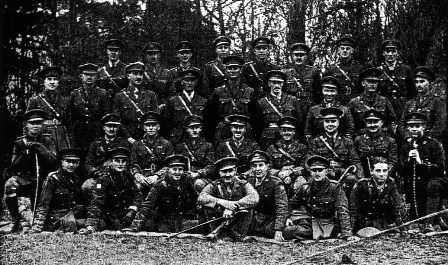
Top Row: Second Lieutenants George Wilmot CHILDS, William Dent Frank SMITH, Albert Victor CLARK MC, David Harold MACKLIN, Leonard HUMPHREYS MC, Lionel HAMBLING MC, Walter Isaac BROUGHTON, Oliver Jack SOAMES.
3rd Row: Lieutenant H.R. SINCLAIR (RAMC), Second Lieutenants R.D. WEBB, Thomas GEE, Max August KRUGER, Robert Charles FYNN, Captain J.H.E. SANDFORD, Lt Algernon Smee LOCKHART, 2/Lt Francis Herbert SHAW, Lt C.R. EDWARDS
2nd Row: 2/Lt Arthur Hayes, Captains Arthur Cyril CROSKELL, Frederick Thomas SPICER, MBE, MC (biography above), Leslie Grantham PLUMBLY MC, Major Farquhar William Forbes LATHOM MC, Captain John Humphrey BLACKWELL MC & Bar, The Reverend H.G. SOUTH, Captain and Quartermaster Robert John BARRY, 2/Lt Leslie Arthur Walter VINCENT
Bottom Row: 2/Lts Percival SHOTT, W.B. STIMSON MC, Lieutenants Ernest Dennis ELLIS, Arthur Tyrell BLACKETT, James Bowen PRIMROSE-WELLS, 2/Lt Frederick Alick GIRLING, Lt C. KEITH-JOHNSON MC
Sergeants of the 4th Battalion September 1917
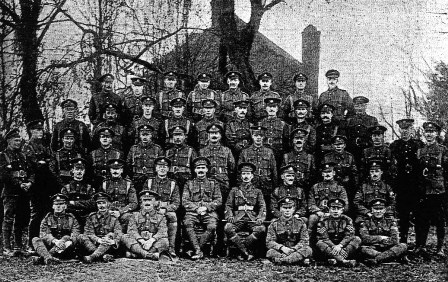
Sergeant 4/6663 William Marks MM, and the 4th Battalion band
Below is what is presumed to be the band of the 4th Bedfordshires, based on the presence of Corporal 4/6663 William Marks MM (seated, to the left of the bass drum as you look) and the bass drum bearing the 'Hartfordshire' Militia title. William would go on to be mentioned in dispatches at the end of December 1917, probably for his involvement in the battalion's costly assault in October, then be awarded the Military Medal for gallantry during the German Spring Offensives in March 1918.
On 22 March William was a Sergeant in charge of a transport section who found themselves under heavy gas and explosive barrage. Having sustained casualties, he calmly held the men together and continued directing them from post to post, as per their orders. Despite suffering from exposure to gas himself, once the Transport Officer had been lost, Sergeant Marks took charge of the transport section and ld them through the intense battle and retirements, his calm and controlled demeanor keeping the men's nerves intact throughout.
[With thanks to Roy Litchfield, and the descendants of William Marks for passing this on for inclusion in the site]
4th Battalion band (1916 ca.)
Here is another great photograph of the battalion's band, presumably dating from before the 4th Battalion were sent to France in July 1916.
From the size of the group, identification clues in the photograph, and the believed location (possibly outside the Tower Hotel in Dovercourt), this is certainly the 4th (Special Reserve) band, but may well include elements of the 3rd (Reserve) Battalion band who have joined to combine into a Massed Band for some purpose. The bass drums bear the titles '4th Bn Bedfordshire' (left side) and 'Hartfordshire' (right side, later the 4th Bedfordshires), with the three snare drum carrying the 'Hartfordshire Militia' title.
Seated in the centre is probably Lieutenant Colonel Page-Croft, who is surrounded by men sporting an array of long service chevrons, South African War medals and trade / proficiency badges.
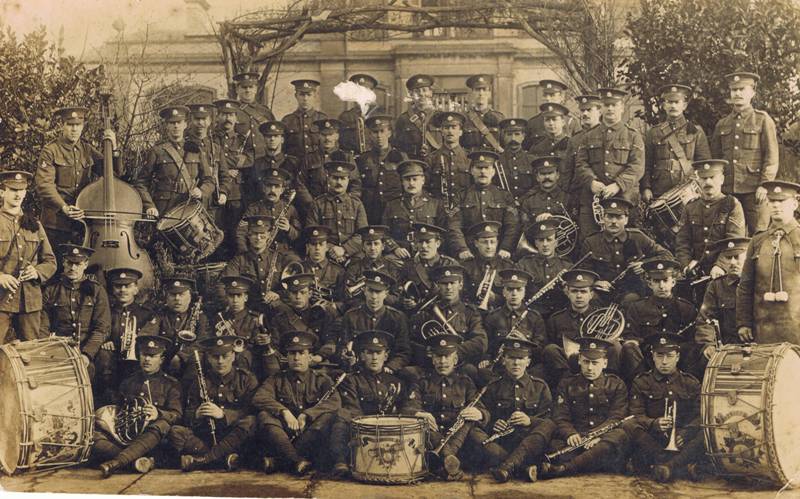
[With thanks to Peter Haywood for sharing this]
|
In April 1918 the British army faced a considerable manpower shortage after their losses during the March and April fighting. One of the effects of this shortage saw the law change to enable men of 18 years and 6 months to serve abroad. These young men were dubbed 'A4's' after their medical classification and were often thrust into desperate situations having just undergone basic training. Below are two examples of these young 'A4's', Stan Kingham and Harold Meek. Private 52074 Percy Stanley Kingham Stan as he was known, was born in Abbots Langley on 11 November 1899. Once he reached call up age in November 1917, Stan received his papers and started training in December, initially serving as Private 36588 in the Norfolk Regiment. As a consequence of the British losses suffered during the German Spring Offensives in March 1918, Stan was among those drafted to the front in May 1918 and posted to the 4th Bedfordshires on arrival, in which battalion he would serve through the final intensive battles of the war. Stan is seated on the right of the group studio photograph (below) which is labeled as being taken in Cöln, so would have been while he served in the Army of Occupation near Cologne in 1919. He is also second from the left on the outdoors photograph. Once the British Army of the Rhine was disbanded in April 1920, Stan was demobilized from service and returned to civilian life. After the war, Stan was involved in the family firm, W.G. Kingham Printers, who were based on the Kings Langley High Street for most of his life. He died on 31 October 1956 in Kings Langley Private 51231 Harold Meek Harold was born 24 April 1899 in Willesden. From his service numbers it appears he enlisted late in April 1917 which ties in with when he would have received his call up papers on his eighteenth birthday. At the time he was living in Mill Hill. He became Private 51231 and was posted to the 4th Bedfordshires on arrival in France, which would have been at around the same time as Stan Kingham (above). During the '100 Days' of allied offensives that led to the end of hostilities, Harold was mortally wounded on 30 September 1918. Although he was moved back to the casualty Clearing Station in Proville, he died from his wounds the same day and was interred in what is now the Proville British cemetery, near Cambrai. He was just 19 years old. Whether the two young men knew one another is unknown, but whether through coincidence or not, Stan's younger brother married Harold's sister in 1939, which often signifies a link was forged between the two families during their service. [My thanks to Ian Dunn, the descendant of both soldiers, for sharing the photos with the site]
|
|
Private 40624 Alfred Albert BONHAM
Alfred was killed in action on the 30th October 1917 as the Battalion tried in vain to assault German positions in the knee deep mud of the Battle of Passchendaele. Conditions were nothing short of appalling and the entire Brigade hardly got out of their trenches, let alone made it to the enemy front lines. Over 400 men of his Battalion became casualties that day as well as all bar two of the Officers. Like many others lost that day, Alfred has no known grave but is remembered on panels 48 to 50 of the Tyne Cot memorial to the missing. |
Private 29725 William Henry PAPWORTH, M.M.
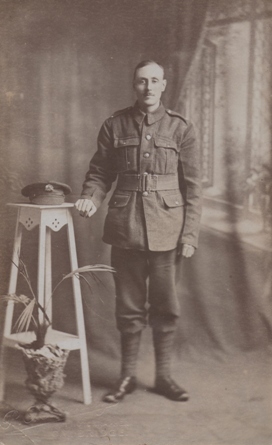 William
was born on 10 July 1887, the fifth child of seven and elder son of
Henry Richard and Harriet Jane Papworth. His father Henry was a printer
at the Cambridge University Press, and William was educated at the Perse
School and a member of Trinity College Choir Cambridge. At some point
after leaving school he became a Clerk for the Cambridge University
Highest Grade Schools Examination Syndicate and on 8 April 1912 he married
Ethel Mary Livermore from Fulbourn Cambridge.
William
was born on 10 July 1887, the fifth child of seven and elder son of
Henry Richard and Harriet Jane Papworth. His father Henry was a printer
at the Cambridge University Press, and William was educated at the Perse
School and a member of Trinity College Choir Cambridge. At some point
after leaving school he became a Clerk for the Cambridge University
Highest Grade Schools Examination Syndicate and on 8 April 1912 he married
Ethel Mary Livermore from Fulbourn Cambridge.
William enlisted at Cambridge around the time of the Derby Scheme late in 1915, or upon the introduction of the Military Service Act early in 1916, joining into the 4th Battalion. He trained and provided home defence around Felixstowe and Dovercourt and appeared in the group photograph (below) taken outside a hut by the Felixstowe photographer "Emeny".
On 10 July 1916 - William's 29th birthday- the 4th Battalion received orders to prepare for overseas service and moved across the estuary to Landguard Fort in Felixstowe. Once arrangements for mobilisation were complete, on 24 July, they boarded trains at the Felixstowe station, and travelled to Southampton where they embarked on board the SS Inventor headed for France.
Arriving in Le Havre at 6 a.m. on the 25th, the battalion marched to base camp for a few hours rest before boarding trains again for the journey to Coupigny in northern France. On arrival, they joined the newly formed 190th Infantry Brigade who had been formed to serve as part of the 63rd (Royal Naval) Division.
As William was preparing to move into the front line for the first time, he would have received the news that his second son Reginald William had been born on 31 August, although he could not know that the two would never meet.
William and his battalion moved to the northern fringe of the Somme battlefields and were engaged in the Somme's final action of 1916, being the Battle of the Ancre. 1917 saw them engaged in the Battles of Arras, the Third Battle of Ypres and the Action at Welch Ridge at the end of the year. During the German Spring Offensives of March 1918, they were heavily engaged once more and once the final '100 Days' offensives were launched, found themselves committed to several more costly battles.
During the Battle of the Canal du Nord on 27 September 1918, the battalion was engaged in heavy fighting on the banks of the canal near Moeuvres, capturing a large number of prisoners and six field guns. William Papworth was killed by shell fire that day while taking prisoners back, for which he was awarded the Military Medal posthumously.
William, aged 31, left a widow and young family, and today lies in the Moeuvres Communal cemetery extension.
[With thanks to Richard Papworth for the personal information and photographs]
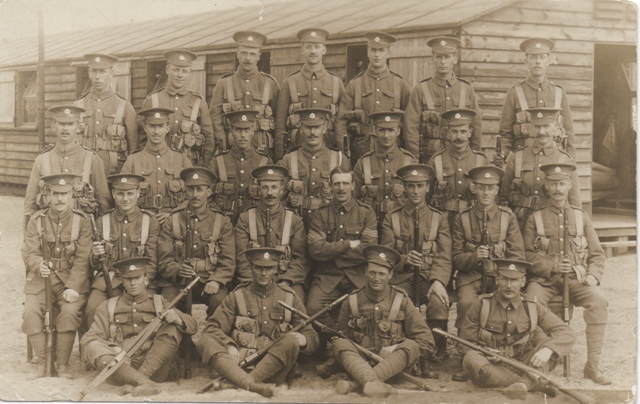
Men of the 4th Battalion early in 1916
Site built by Steven Fuller, 2003 to 2023
